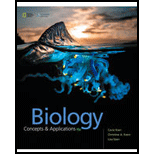
Concept explainers
To identify:
The type of biological molecule having the monomers: methionine-valine-proline-leucine-serine.
Introduction:
The molecules that are present in a living system are known as biological molecules. These molecules are necessary for life to perform different processes. Four different types of
To identify:
The biological molecule having molecular formula
Introduction:
The molecules that are present in a living system are known as biological molecules. These molecules are necessary for life to perform different processes. Four different types of biomolecules are carbohydrates, proteins, fats, and nucleic acids.
To identify:
The biological molecule having structure
Introduction:
The molecules that are present in a living system are known as biological molecules. These molecules are necessary for life to perform different processes. Four different types of biomolecules are carbohydrates, proteins, fats, and nucleic acids.
To identify:
The biological molecule having structure
Introduction:
The molecules that are present in a living system are known as biological molecules. These molecules are necessary for life to perform different processes. Four different types of biomolecules are carbohydrates, proteins, fats, and nucleic acids.
Want to see the full answer?
Check out a sample textbook solution
Chapter 3 Solutions
BIOLOGY:CONCEPTS+APPL.(LOOSELEAF)
- In the following list, identify the carbohydrate, the fatty acid, the amino acid, and the polypeptide: a. NH2CHRCOOH b. C6H12O6 c. (methionine)20 d. CH3(CH2)16COOHarrow_forwardHydrolysis of a mixture of glycerophospholipids may yield the following, EXCEPT: A. Galactose B. Choline C. Serine amino acid D. Phosphatearrow_forwardConsider the trisaccharide below and answer the following questions: но. OH OH H. OH HO Но ОН ÓH H ÓH ОН C Name of monosaccharide A (Follow this format in typing your answer: ribose): Name the glycosidic linkage between monosaccharides A and B. (strictly follow this format, do not put spaces in between: beta-1,2): Is the trisaccharide a reducing sugar? Type Yes or No: I- I-arrow_forward
- A) Refer to the figure below, Identify and explain the two types of reactions, and describe what are the importance of these reactions to our bodies. Reaction 1 H Monomer Reaction 2 H H OH + H H H₂O H H₂O OH + H H OH OH + H H₂O H₂O OH OH + H OH OH OH OH B) What are the main chemical interactions that determine and maintain the quaternary structure of proteins. Also, what are the conditions that can alter these interactions? [arrow_forwardWhich of the following statements regarding lipids is most accurate? 1. Lipids are synthesized by ribosomes 2. Saturated fats tend to be solid at room temperature because of the polar hydrocarbon chains 3. Saturated fats tend to be liquid at room temperature due to hydrogen bonding 4. Polyunsaturated fats tend to be liquid at room temperature due to numerous double bonds in the hydrocarbon chains 5. The empirical formula for lipids is typically C1H201arrow_forwardWhich of the following shorthand names best characterizes the following disaccharide? a. Glc (β1→4)Gal b. Gal (β1→4)Glc c. Gal (α1→4)Glc d. Glc (α1→4)Galarrow_forward
- Which of the following statements regarding lipids is most accurate? 1. The empirical formula for lipids is typically C1H201 2. Saturated fats tend to be solid at room temperature because of the polar hydrocarbon Chain. 3. Polyunsaturated fats tend to be liquid at room temperature due to numerous double bonds in the hydrocarbon chains 4. Saturated fats tend to be liquid at room fèmperature due to hydrogen bonding 5. Lipids are synthesized by ribosomesarrow_forwardWhich stereoisomer of the monosaccharide threose is shown below? a. D b. L c. R d. Sarrow_forwardWhich of the following molecular formulas would be for an aldopentose? C4H8O4 C₂H₁408 C6H12O6 C5H1005 Darrow_forward
- Construct the two enantiomeric forms/structure of the following monosaccharides and designate the handedness of each using D, L system: a. Ribulosearrow_forwardPage 3 of 6 Previous Next For items 16-20, determine the monosaccharide units for each carbohydrate. Choic are: A. B-D-galactopyranose, and D-glucopyranose B. a-D-glucopyranose and D-glucopyranose C. N-acetyl-galactosamine D. B-D-glucuronate-2-sulfate, E. N-acetyl-B-D-glucosamine, and D-glucuronate 16. Maltose 17. Lactose and N-sulfo-D-glucosamine-6-sulfate 18. A-antigen oligosaccharide (end unit) 19. Heparin 20. Hyaluronic acid 344arrow_forwardWhich of the following names best describes the molecule? A. Pentose B. α-glucose C. β-fructose D. L-sugar E. ketosearrow_forward

 Biology Today and Tomorrow without Physiology (Mi...BiologyISBN:9781305117396Author:Cecie Starr, Christine Evers, Lisa StarrPublisher:Cengage Learning
Biology Today and Tomorrow without Physiology (Mi...BiologyISBN:9781305117396Author:Cecie Starr, Christine Evers, Lisa StarrPublisher:Cengage Learning

